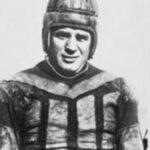Back in the very early days of the National Football League, many of the players were multi-sport athletes. For example, George Halas of the Chicago Bears also played major league baseball with the New York Yankees.
There is, of course, an old tale that Babe Ruth replaced him in right field for the Yankees! Not true, but it is an interesting concept. Then there was Paddy Driscoll who played football with the Chicago Cardinals and was the highest-paid player in the NFL in 1920, earning $300 per game when most individuals were paid $25 to $50 per outing. Driscoll, although standing just 5-7, also played pro basketball and was once a member of the Chicago Cubs baseball team.
In this episode of “When Football Was Football,” we’ll take a look at the short, but brilliant career of an exceptional pro football player who is also in the Basketball Hall of Fame.
For those who enjoy very deep dives into professional football history, you probably do not remember him as the person who scored the very first NFL touchdown ever for the team known today as the Arizona Cardinals. More than likely, you have never heard of him and his amazing athletic accomplishments, both on the gridiron and on the hardcourt!
Our focus today will be on Lenny Sachs who was born in 1897 in Chicago. He attended Carl Schurz High School and apparently won 11 letters in different sports—once even getting into minor trouble for his participation.
On November 8, 1913, while still a high school senior, Sachs “starred” (according to the Chicago Tribune) for Schurz in an important soccer (not football) game for Schurz. It was a 3-3 deadlock with Englewood High School. Schurz trailed 3-0 before Sachs led his team back in the final ten minutes of the match.
On November 13, the Chicago High School Board of Control ruled that Schurz must forfeit the soccer game to Englewood because Sachs had been the starting quarterback for Schurz in its football game against Englewood on October 19. Apparently, there was some type of rule in existence at the time that did not allow an athlete to play two sports during the same season.
After high school, Sachs attended the American College of Physical Education and also enlisted in the service during World War I where he played basketball for the Cleveland Naval Reserve basketball team. He had also played some semi-pro football in Chicago with the Logan Squares as a left end. In addition, he was also the left forward for a basketball team called the Mezerkons in 1917.
Blocks Three Punts In One Quarter!
After the war, Sachs joined the rough and tumble Chicago Cardinals team on Chicago’s south side, managed by Chris O’Brien. Of course, O’Brien was one of the founders of the National Football League-or as it was called in 1920—the American Professional Football Association.
Football season started a bit later back then and the Cardinals failed to score in their first two league games: a 0-0 tie with the Chicago Tigers on October 10 and a 7-0 loss at Rock Island on October 24. But, it was on October 31, 1920, that Sachs achieved his historical record in a 21-0 rout of the Detroit Heralds. Actually, there were two milestones that Sachs established that day!
Detroit and the Cardinals battled to a scoreless tie in the first half, but within five minutes in the third quarter, Lenny Sachs changed history. First, let’s talk about his touchdown. As mentioned, the Cardinals were scoreless in their first two outings and failed to dent the end zone in the first half against Detroit.
That adds up to ten quarters without a point! But in the third quarter, Sachs hit pay dirt in a most unusual way as described by the Rock Island Argus newspaper: “Three blocked punts in rapid-fire order by [Lenny] Sachs, Racine Cardinal end, were converted into touchdowns and enabled the local team to turn back the Detroit Heralds with a 21-0 defeat at the Cubs Park.”
First TD In Cardinals' History
It is still amazing to think that one player could block three punts in one game, let alone one quarter! But Sachs did the job, and when he recovered the first block in the end zone, he also owned the very first NFL score in the long history of the Cardinals.
The Argus then added a few more details to verify the momentous effort of Sachs: “Sachs’ playing was sensational throughout the game, but in the third quarter he set a record which has probably been equaled few times on a football field. Three times he broke through the line and knocked down the ball before the punter could get rid of it. Once he recovered and scored the touchdown.”
Tracking down this type of archaic record in the NFL can be challenging and we could not find any other example of a player blocking three punts in one quarter. Two players, Steve Broussard of Green Bay in 1975 and Jim Fraser of Denver in 1963 are credited with three blocked punts in a single game. Sadly, the feat of Lenny Sachs is nowhere to be found.
Sachs played pro football through 1926 with the Cardinals, Milwaukee, Hammond, and Louisville all while maintaining a break-neck coaching schedule as well. His first coaching stint was at Wendell Phillips High School on the south side of Chicago, where he was in charge of both the basketball and football programs.
In 1921, he moved over to Marshall High School on the west side of Chicago. By 1923, while still playing pro football, Sachs took on the dual role of a coach at both Loyola University and Loyola Academy, a prep school.
34 Straight Basketball Wins
His basketball teams at Loyola University were among the finest in the country. Beginning in 1928 and extending into the 1930 season, the hoops team under Sachs won an amazing 34 straight games. Then from 1938-39, Loyola put together another 21-game winning streak, losing in the national championship game.
Sachs was considered a defensive genius who developed a stifling 2-2-1 zone defense that took advantage of the lenient rules at the time. Sachs would position his biggest man under the basket where it was open season on goaltending. As the big guys would swat away the shots, Loyola would grab the loose balls and head the other way. Although goaltending was outlawed in 1937, Sachs still employed a tight defense as his trademark for the Loyola teams.
In 1939, Loyola finished 21-1 and was the runner-up in the National Invitation Tournament (NIT). He won 223 games at Loyola against only 129 losses over 19 seasons. His coaching wins are the second-most in school history and he was inducted into the Naismith Basketball Hall of Fame in 1961. He was also Loyola’s first athletic director from 1935-1940.
In 1939, Bill Reinhart of Washington University said: “Lenny Sachs has an experienced and smart club. Loyola, in my opinion, would hold up against any kind of competition.”
Finest Basketball Coach in the Country
Sachs died suddenly in October of 1942 at the young age of 45. The school said: “We regard him as the finest basketball coach in the country, one who exercised a profound influence on the young men who came under his direction.” Lenny Sachs was a multi-sport athlete who made his mark as just a 5-7, 180 lb. lineman back in the days “When Football Was Football.”
And we’d like to share one more brief story about an early Chicago Cardinal player who made a lasting impact in another field.
Cards Lineman Earns PHD
Herb Blumer was another sturdy lineman who expressed little interest in playing in the NFL for an extended period of time, but at the same time, he became an MVP in the academic world. While he was playing for the Cardinals from 1925-1930, and again in 1933, Herb Blumer decided to work toward a Ph.D. at the nearby University of Chicago.
Once he finished his degree at Chicago, Blumer was a member of the faculty through the 1952 school year. He also found time to work as the line coach under Clark Shaughnessy for the Maroons football squad. Later, he accepted a position at the University of California and eventually became the chairman of the sociology department.
Highly regarded in his field of academic pursuit, Blumer also served as the president of the prestigious American Sociological Association. Considered an expert on the football field in the skills of blocking and tackling, in the arena of sociology Blumer “was considered an expert in the fields of collective behavior, social movement, race relations, social problems, and public opinion.”
As such, Blumer who proudly defended his quarterback both at the University of Missouri and with the Chicago Cardinals, smoothly and successfully immersed himself in the field of sociology. Blumer’s innovative specialty was called Symbolic Interactionism.
He is known as the first individual to utilize that phrase and he is also remembered as the founder of Symbolic Interactionism. Dr. Herb Blumer passed away on April 13, 1987. He was 87 years old.
Thank you for joining us for this episode of “When Football Was Football” and we hope to be with you next time when we’ll look at one of the ugliest marks in pro football history: the record 29 game losing streak of the Chicago Cardinals. When you hear this story, you’ll never feel bad again when your favorite team happens to lose two or three in a row!
Author and Host - Joe Ziemba
Joe Ziemba is the host of this show, and he is an author of early football history in the city of Chicago. Here, you can learn more about Joe and When Football Was Football, including all of the episodes of the podcast.
Please Note – As an Amazon Associate I earn from qualifying purchases
Resources
More From When Football Was Football
Searching for the “Zest” of the 1931 Chicago Bears
Throughout the history of professional football, every so often you...
Read MoreUgly Passers, Brick Walls, and Feisty Cardinals
Since the Arizona Cardinals are the NFL’s oldest team, with...
Read MoreThe NFL’s Forgotten Gold Medalist!
As usual during the staging of the Summer Olympics, numerous...
Read MorePaddy Driscoll’s Almost Perfect Season
Back at the beginning of the National Football League in...
Read More


